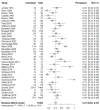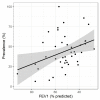A Systematic Review and Meta-Analysis of the Prevalence and Impact of Pulmonary Bacterial Colonisation in Stable State Chronic Obstructive Pulmonary Disease (COPD)
- PMID: 35052762
- PMCID: PMC8773377
- DOI: 10.3390/biomedicines10010081
A Systematic Review and Meta-Analysis of the Prevalence and Impact of Pulmonary Bacterial Colonisation in Stable State Chronic Obstructive Pulmonary Disease (COPD)
Abstract
Background: Half of acute exacerbations of COPD are due to bacterial infection, and the other half are likely influenced by microbial colonisation. The same organisms commonly cultured during acute exacerbations are often found in the sputum of patients during stability. A robust assessment of the prevalence of potentially pathogenic microorganisms (PPMs) in the sputum of stable COPD patients may help to inform the targeted prevention of exacerbation by these organisms.
Methods: A systematic review and meta-analysis was carried out to determine the prevalence of PPMs in patients with COPD in the stable state. Meta-analysis of prevalence was carried out using the Freeman-Tukey double arcsine transformation random effects model, and sub-group analysis was performed for sputum modality. Prevalence of total and individual PPMs was calculated from patient-level data from individual studies.
Results: Pooled prevalence of PPMs identified by sputum culture was found to be 41% (95% CI 36-47%). Significant heterogeneity was found across all studies, which can likely be attributed to inconsistent measuring and reporting of PPMs. The most commonly reported organisms were H. influenzae, M catarrhalis, S. pneumoniae, S. aureus, and P. aeruginosa. Declining lung function was weakly correlated with prevalence of PPMs.
Conclusion: The airways of patients with COPD are colonised with PPMs during the stable state in almost half of patients. A complex relationship likely exists between the microbiome in the stable state and the phenotype of COPD patients. Targeted microbial therapy for preventing exacerbations of COPD should carefully consider the stable microbiome as well as the exacerbated.
Keywords: COPD; chronic bronchitis; colonisation; emphysema; prevalence; stable.
Conflict of interest statement
The authors declare no conflict of interest.
Figures





References
-
- Cabello H., Torres A., Celis R., El-Ebiary M., De La Bellacasa J.P., Xaubet A., Gonzalez J., Agusti C., Soler N. Bacterial colonization of distal airways in healthy subjects and chronic lung disease: A bronchoscopic study. Eur. Respir. J. 1997;10:1137. doi: 10.1183/09031936.97.10051137. - DOI - PubMed
-
- Desai H., Eschberger K., Wrona C., Grove L., Agrawal A., Grant B., Yin J., Parameswaran G.I., Murphy T., Sethi S. Bacterial Colonization Increases Daily Symptoms in Patients with Chronic Obstructive Pulmonary Disease. Ann. Am. Thorac. Soc. 2014;11:303–309. doi: 10.1513/AnnalsATS.201310-350OC. - DOI - PubMed
Publication types
LinkOut - more resources
Full Text Sources

